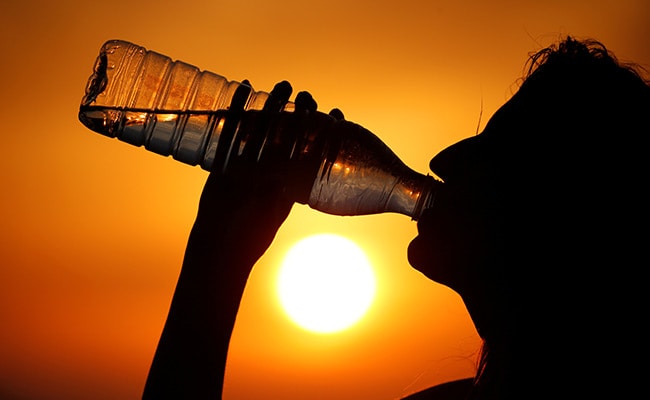2024-06-27 13:10:40

Sweating is the most powerful way your body can remove heat. (Representational)
Lancaster, UK:
As the heatwave begins to grip the UK and the heat health alert is in effect, people are looking for ways to keep cool and reduce the risk of heat stroke – the most severe form of hyperthermia, with a body temperature above 40°C.
Older adults, those with underlying health conditions and the very young are at greatest risk. Some of this arises because the young and elderly have less efficient body systems to dissipate heat away from the body.
Older people hold heat more than young people because their sweat glands don’t function as well and their hearts don’t circulate blood as efficiently, so less heat is lost from the skin.
Sweating is the most powerful way your body can remove heat. As sweat evaporates, it takes heat with it. In the heat, people can produce between a half to two litres of sweat per hour.
In temperatures where the air temp is above the body temperature, heat can be transferred from the air to the body, which produces an additional challenge in removing heat from the body.
Aside from sweating, the other major way we lose heat is vasodilation (a widening of the blood vessels) in peripheral tissues. In extreme heat, the skin can receive between six and eight litres of blood per minute to help carry heat away from central organs.
Much of how the body responds is aimed at moving heat away from the major organs and the central nervous system to keep their temperature at as close to 37°C as possible.
While sweating and vasodilation are effective, they are limited – especially when temperatures stay high for several days.
The best ways to reduce your temperature are ones that support the body’s existing mechanisms to remove heat.
Applying cold things to the body
Applying cold water or a cold damp sponge to the skin is effective in moving heat from the body. This is beneficial in people with limited mobility and older adults.
Those who are able, can take a cool shower or bath. Evidence suggests that water that is about 26 or 27°C is optimal. It is cool enough to take heat away from the body, but not cold enough to initiate shivering, which will generate heat. (Immersing in water that is too cold can also cause cold shock.)
Studies looking at the French heatwave of 2003 showed that cooling (using a mister, cool, or cold bath or shower, sponge bath, mechanical fan or air conditioner) may be beneficial and prevented heat-related deaths.
Ice or cool packs (a damp towel or cloth works just fine) can be applied to the body. The groin, armpit, neck, forehead, wrists and torso are all areas that have plenty of blood vessels close to the surface. The cooled blood can then return to the major organs to bring the core temperature down.
Ice or ice packs should be wrapped in a towel or something similar to avoid burning the skin. Cycling them on and off the body every ten minutes reduces the risk of injury.
Partial filling of hot water bottle and placing in the freezer, to use at bedtime, or placing pillowcases in a plastic bag and into the freezer to chill them for bedtime may also help at night.
Fans
A recent study has shown that fans can improve the body’s sweat evaporation, but not significantly enough to help reduce the core body temperature. And this becomes even less so when ambient temperatures rise above 33°C, or for older people and those with an impaired ability to sweat.
Hot and cold drinks
Evidence from performance athletes exercising in temperatures of 28°C showed that chilled fluids at fridge temperature were better at bringing down core temperatures than ice or temperature neutral liquids at 37°C.
Drinking hot beverages activates the body’s mechanism to cool, but this will remove much-needed fluid from the body if you haven’t drunk enough, so chilled drinks are probably best in this situation.
Shade
All of these things are more effective in a cooler shaded area to increase the temperature gradient between the body and the ambient temperature. If you try these in the sun, they’re likely to be less effective as the ambient air is warmer in the sun meaning there is less capacity to take heat away or it happens more slowly.
Overall, though, the evidence suggests (ice) water immersion is the most effective way to cool off – which at home is most easily done by immersing feet or hands in a cool bowl of water. Water immersion is how many animals in hot weather and climates reduce their body temperature by standing in water, so it’s a good technique for humans, too.
But if you’re unable to do this, evaporation (mist and fan) is the next most effective.![]()
(Author:Adam Taylor, Professor and Director of the Clinical Anatomy Learning Centre, Lancaster University)
(Disclosure Statement:Adam Taylor does not work for, consult, own shares in or receive funding from any company or organisation that would benefit from this article, and has disclosed no relevant affiliations beyond their academic appointment)
This article is republished from The Conversation under a Creative Commons license. Read the original article.
(Except for the headline, this story has not been edited by NDTV staff and is published from a syndicated feed.)
Heatwave,How To Stay Cool During A Heatwave,How To Stay Cool In Hot Weather,Beat The Heat
Source link
15 total views , 1 views today
